Thomas Cheplo
-
- CIT Takes Issue With Customs' Duty Calculation in Dry-Docking Case Maritime Reporter, Nov 2001 #21
The vessel repair statute (Section 466 of the Tariff Act of 1930, 19 U.S.C. § 1466) requires the payment of a 50 percent ad valorem duty on the cost of foreign equipment purchased for, or expenses of repairs made to, U.S.-flag vessels in a foreign country. The purpose of the vessel repair statute is to protect U.S. shipyards and to discourage vessel operators from taking their vessels abroad for the purpose of obtaining less expensive foreign repairs. The U.S. Court of International Trade determined that "section 1466 expresses the legislative policy designed to provide maximum protection to American shipyards." Mount Washington Tanker Co. v. United States, 505 F. Supp. 209. 214 (1980), affd, 665 F.2d340 (C.C.P.A. 1981). In the court's view: "It cannot be questioned that the protection of the domestic shipbuilding and repair industries was of paramount importance in the enactment of this legislation." The U.S. Customs Service interprets and applies the vessel repair statute through letter rulings, but its interpretations of the statute have not been without controversy.
One frequently contested issue concerns the manner in which Customs determines duties in connection with dry-docking expenses. Such expenses, or portions thereof, are not necessarily related to dutiable repairs that might be performed simultaneously with non-dutiable inspections and/or modifications for the convenience of the vessel owner. The leading case in this area is Texaco Marine Services, Inc. v. United States, 44 F.3d 1539 (Fed. Cir. 1994), in which the Federal Circuit determined that the cost of dry-docking and any costs related to dry-docking are dutiable repairs, provided that such costs would not have been incurred "but for" the dutiable repairs. Application of the "but-for" test is relatively simple in situations where the dry-docking is undertaken to perform either dutiable repairs or non-dutiable inspections and/or modifications, but becomes complicated where both dutiable and nondutiable work is performed during the drydocking (so called "mixed purpose" dry-dockings).
In a recent ruling, the Court of International Trade found the pro-rata apportionment used by the United States Customs Service in its application of the Texaco "but for" test to be "arbitrary, capricious, and in violation of the classification designated by Texaco." American Ship Management, LLC v. United States, Consolidated Court No. 99-03-00151, slip op.
01-105 (Ct. Int'l Trade, decided Aug. 17, 2001). The court denied American Ship Management's motion, and Customs' cross-motion, for summary judgment, stating that triable issues of material fact remain regarding the determination of dutiable expenses related to the dry-docking.
The American Ship Management case involves two vessels that were put into drydock to comply with mandatory United States Coast Guard and American Bureau of Shipping inspection and modification requirements.
While in dry-dock, the vessels underwent dutiable repairs in addition to the non-dutiable inspections and modifications. To calculate the total value of dutiable dry-docking expenses, the Customs Service used a pro-rata apportionment formula whereby it divided the cost of dutiable repairs by the sum of the total cost of dutiable repairs and the total cost of non-dutiable inspections and modifications, and then multiplied the resulting percentage by the total dry-docking expenses.
Contrary to American Ship Management's contention, the court held that an apportionment of dry-docking expenses is not per-se illegal, so long as the dutiable dry-docking expenses undertaken solely for the purpose of repair and the nondutiable dry-docking expenses undertaken for a purpose either unrelated to repair or for a mixed purpose are clearly identified.
However, the court condemned the particular apportionment used by Customs as arbitrary and in violation of Texaco.
The court noted that the Texaco decision specified that "[tjhe mere drawing up of a vessel on a dry dock is not a part of her repairs, but is rather a method of making an inspection of her to determine whether any repairs are necessary." Again citing Texaco, the court stated that "the cost of tugs is an inevitable expense of a mandatory inspection and, thus, is not dutiable." The court added that all maintenance charges in connection with the dry-docking during the period of mandatory inspection and/or modifications are nondutiable under Texaco, notwithstanding whether or not any repair was performed during the same period. The court stressed the importance of the timing of dutiable repairs relative to the completion of non-dutiable inspections and/or modifications, holding that "only the maintenance expense of dry-docking for the period of time in excess of that necessary for a mandatory inspection and/or modifications are dutiable under the Texaco test." Judging from the Customs Service's past treatment of challenges to its interpretation and application of the Texaco case, a settlement in American Ship Management is unlikely. If the CIT's holdings are upheld, Customs may be forced to move from a percentage-based apportionment to a simple examination of timing in assessing duties related to dry-docking.
As a result, dry-docking expenses would not be dutiable where dry-docking is performed to carry out duty-free inspections and/or modifications, even if dutiable repairs are performed simultaneously. If, however, dutiable repairs are conducted after the time necessary for duty-free inspections and/or modifications has expired, then the cost of continuing the dry-docking from that point forward would be dutiable.
Thomas Cheplo is an attorney at Dyer Ellis c£ Joseph, P.C., a Washington, D.C.
based law firm with a domestic and international practice involving transportation, shipping, finance, corporate, securities, legislative, environmental, and trade matters.
-
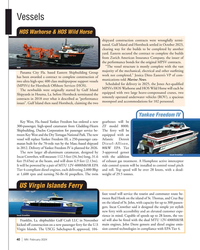 )
February 2024 - Marine News page: 40
)
February 2024 - Marine News page: 40. The twin weight of 29.5 tonnes. US Virgin Islands Ferry foot vessel will service the tourist and commuter route be- tween Red Hook on the island of St. Thomas, and Cruz Bay on the island of St. John, with capacity for up to 300 passen- gers. Incat Crowther said it designed the simple yet stylish new ferry
-
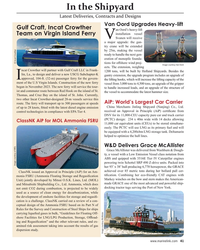 )
January 2024 - Maritime Reporter and Engineering News page: 41
)
January 2024 - Maritime Reporter and Engineering News page: 41loads, and an upgrade of the structure of ist and commuter route between Red Hook on the island of St. the vessel to accommodate the latest hammer size. Thomas, and Cruz Bay on the island of St. John. Currently, two other Incat Crowther-designed 28-m vessels service this AiP: World’s Largest Car Carrier
-
 )
September 2023 - Marine Technology Reporter page: 60
)
September 2023 - Marine Technology Reporter page: 60lu um mn n n n n n n n n n w with man n nip pu ul l l l l l lato or r r r r r r r rs s exte e en nd de ed d d d d d d. Courtesy Framework Robotics © DFKI, Thomas Frank of its vehicle components are made on its 3D printer, speci? - to autonomously detect and handle critical infrastructures un- cally an industrialized
-
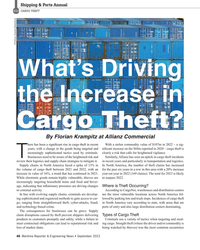 )
September 2023 - Maritime Reporter and Engineering News page: 46
)
September 2023 - Maritime Reporter and Engineering News page: 46Shipping & Ports Annual 2023 CARGO THEFT ©Thomas Sztanek/AdobeStock What’s Driving the Increase in Cargo Theft? By Florian Krampitz at Allianz Commercial here has been a signi? cant rise in cargo theft in recent With a stolen commodity value of $107m in 2022 – a sig- years, with a change in the goods
-
 )
July 2023 - Marine Technology Reporter page: 32
)
July 2023 - Marine Technology Reporter page: 32(partially) autonomous object ma- nipulation. The AUV performs manipulation tasks on an underwater mockup in an upright position. Photo copyright DFKI, Thomas Frank July/August 2023 MTR #5 (18-33).indd 32 7/21/2023 9:13:57 A
-
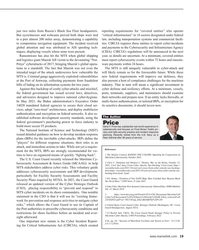 )
June 2023 - Maritime Reporter and Engineering News page: 19
)
June 2023 - Maritime Reporter and Engineering News page: 19quickly “? ghting back”. Maritime Cybersecurity, October 2022. The U.S. Coast Guard recently released the Maritime Cy- 2 Chris C. Demchak and Michael L. Thomas, War on the Rocks, October 15, bersecurity Assessment & Annex Guide (MCAAG) to help 2021, Can’t Sail Away From Cyber Attacks:‘Sea-Hacking’ From
-
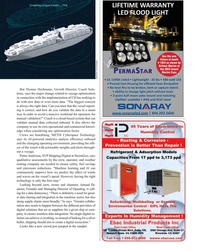 )
May 2023 - Maritime Reporter and Engineering News page: 33
)
May 2023 - Maritime Reporter and Engineering News page: 33• Lightweight - 35 lbs • 500-wa? LED • Poured Cast Housing for e? cient heat dissipaO on • No heat I ns to be broken, bent or capture debris But Thomas Hechmann, Growth Director, Coach Solu- • Ability to change light pitch without tools tions, says the major change related to voyage optimization •
-
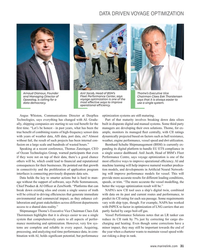 )
May 2023 - Maritime Reporter and Engineering News page: 31
)
May 2023 - Maritime Reporter and Engineering News page: 31. fusion on a large scale and hundreds of wasted hours.” Bernhard Schulte Shipmanagement (BSM) is currently ex- Speaking at a recent conference, Thomas Zanzinger, CEO panding its digital platform to handle EU ETS compliance in of Ocean Technologies Group, warned participants that even a single source
-
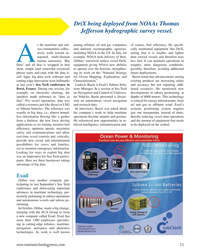 )
January 2023 - Marine Technology Reporter page: 23
)
January 2023 - Marine Technology Reporter page: 23DriX being deployed from NOAAs Thomas Jefferson hydrographic survey vessel. s the maritime and sub- among offshore oil and gas companies of course, fuel ef? ciency. He speci? - sea communities collec- and national oceanographic agencies, cally mentioned equipment like DriX, tively work toward in-
-
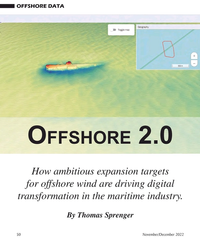 )
November 2022 - Marine Technology Reporter page: 50
)
November 2022 - Marine Technology Reporter page: 50OFFSHORE DATA O 2.0 FFSHORE How ambitious expansion targets for offshore wind are driving digital transformation in the maritime industry. By Thomas Sprenger 50 November/December 2022 MTR #8 (50-63).indd 50 11/29/2022 4:08:15 PM
-
 )
November 2022 - Marine Technology Reporter page: 34
)
November 2022 - Marine Technology Reporter page: 34METHANE EMISSION MONITORING All images: University of Rochester/John Kessler Dr. Thomas Weber (front left) and other scientists deploying hose to pump ocean water for analysis. STEPPING ON THE GAS Rochester researchers team up to tackle methane emissions By Celia Konowe 34 November/December
-
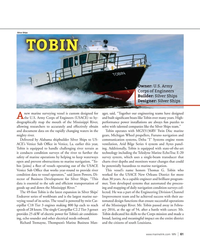 )
November 2022 - Marine News page: 61
)
November 2022 - Marine News page: 61out of the USACE be potentially hazardous to marine navigation. Venice Sub Of? ce that works year-round to provide river This vessel’s name honors Thomas G. Tobin who condition data to vessel operators,” said Jason Powers, Di- worked for the USACE New Orleans District for more rector of Business Development
-
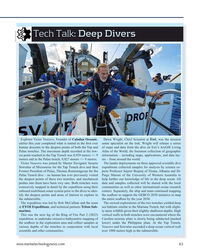 )
September 2022 - Marine Technology Reporter page: 65
)
September 2022 - Marine Technology Reporter page: 65? c dive Sewralur of Micronesia for the Yap Trench dive and then expeditions collected samples for analysis by science ex- Former President of Palau, Thomas Rememngesau for the perts Professor Sajmir Beqiraj of Tirana, Albania and Dr. Palau Trench dive – no human has ever previously visited Paige Maroni
-
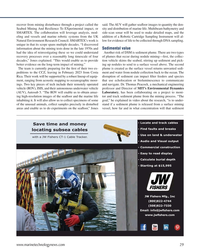 )
September 2022 - Marine Technology Reporter page: 29
)
September 2022 - Marine Technology Reporter page: 29moor- that use echolocation or bioluminescence to communicate ings. Two key pieces of tech include their remotely operated and navigate. Dr. Thomas Peacock, a mechanical engineering vehicle (ROV), ISIS, and their autonomous underwater vehicle professor and Director of MIT’s Environmental Dynamics
-
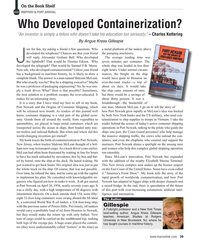 )
September 2022 - Maritime Reporter and Engineering News page: 39
)
September 2022 - Maritime Reporter and Engineering News page: 39your friend the pumping machinery. s will reply, Alexander Graham Bell. Who developed The average loading time was J e the lightbulb? That would be Thomas Edison. Who seven minutes per container. The developed the telegraph? That would be Samuel F.B. Morse. whole ship was loaded in less than Now
-
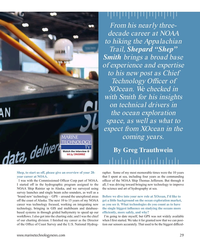 )
July 2022 - Marine Technology Reporter page: 29
)
July 2022 - Marine Technology Reporter page: 29at NOAA. that I spent at sea, including four years as the commanding I was with the Commissioned Of? cer Corp part of NOAA. of? cer of the NOAA Ship Thomas Jefferson. But through it I started off in the hydrographic program assigned to the all, I was driving toward bringing new technology to improve
-
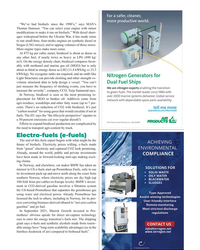 )
May 2022 - Maritime Reporter and Engineering News page: 33
)
May 2022 - Maritime Reporter and Engineering News page: 33“We’ve had biofuels since the 1990’s,” says MAN’s Thomas Hanssen. “You can select your engine with minor modi? cations to make it run on biofuels.” With diesel short- ages widespread before the Ukraine War, it has made sense to run small-bore, four-stroke engines on synthetic diesel or biogas (LNG-mixes)
-
 )
May 2022 - Maritime Reporter and Engineering News page: 26
)
May 2022 - Maritime Reporter and Engineering News page: 26been types, and 2023 should see one that can run on methanol or built yet. They’re being built as we speak. They’ll arrive this diesel. Company exec, Thomas Hanssen, says 2021 saw “a year, next year and in 2024, and that’s when we expect The massive order uptake of ships not using bunker as fuel”, or
-
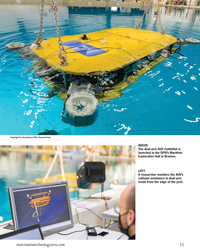 )
May 2022 - Marine Technology Reporter page: 53
)
May 2022 - Marine Technology Reporter page: 53Copyright for all photos is DFKI, Thomas Frank ABOVE The dual-arm AUV Cuttle? sh is launched in the DFKI’s Maritime Exploration Hall in Bremen. LEFT A researcher monitors the AUV’s collision avoidance in dual-arm mode from the edge of the pool. www.marinetechnologynews.com 53 MTR #4 (50-63).indd 53
-
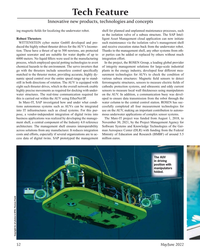 )
May 2022 - Marine Technology Reporter page: 52
)
May 2022 - Marine Technology Reporter page: 52prototyped the management million euros. T T T T T The AUV i in driving p position with m manipulators f fo f f lded. Copyright for all photos is DFKI, Thomas Frank 52 May/June 2022 MTR #4 (50-63).indd 52 4/28/2022 9:13:50 A
-
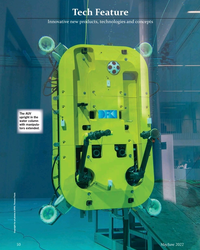 )
May 2022 - Marine Technology Reporter page: 50
)
May 2022 - Marine Technology Reporter page: 50Tech Feature Innovative new products, technologies and concepts T T T T The AUV u upright in the w water column w with manipula- t t to t t rs extended. Copyright for all photos is DFKI, Thomas Frank 50 May/June 2022 MTR #4 (50-63).indd 50 4/28/2022 9:11:19 AM
-
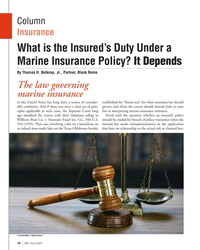 )
April 2022 - Marine News page: 18
)
April 2022 - Marine News page: 18Column Insurance What is the Insured’s Duty Under a Marine Insurance Policy? It Depends By Thomas H. Belknap, Jr., Partner, Blank Rome The law governing marine insurance in the United States has long been a source of consider- established the “litmus test” for when maritime law should able confusion.
-
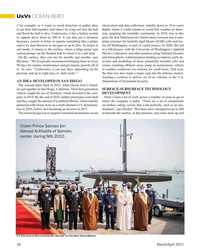 )
March 2022 - Marine Technology Reporter page: 36
)
March 2022 - Marine Technology Reporter page: 36up and Crown Prince Salman bin Hamad Al-Khalifa of Bahrain, center, during IMX 2022. U.S. Navy photo by Mass Communication Specialist 1st Class Mark Thomas Mahmod. 36 March/April 2022 MTR #3 (34-49).indd 36 2/25/2022 10:07:38 A
-
 )
March 2022 - Marine Technology Reporter page: 2
)
March 2022 - Marine Technology Reporter page: 2on the water and a $14 million funding injection to take it the next level. By Elaine Maslin 34 U.S. Navy photo by Mass Comm Specialist 1 Class Mark Thomas Mahmod Teledyne 44 Look Under the Waves to Clear the Air Small autonomous landers for studying the community ecology of nearshore submarine
